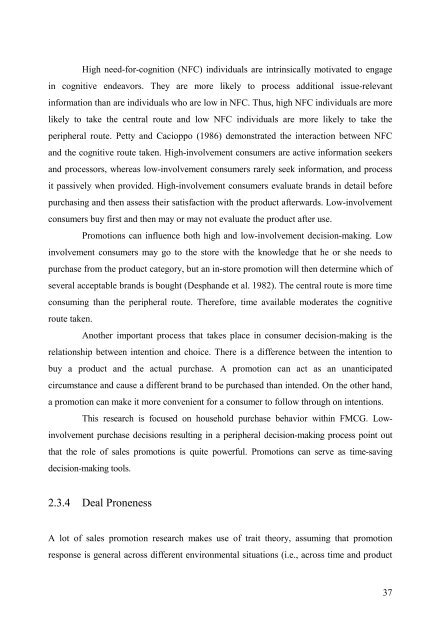Analysis of Sales Promotion Effects on Household Purchase Behavior
Analysis of Sales Promotion Effects on Household Purchase Behavior
Analysis of Sales Promotion Effects on Household Purchase Behavior
You also want an ePaper? Increase the reach of your titles
YUMPU automatically turns print PDFs into web optimized ePapers that Google loves.
High need-for-cogniti<strong>on</strong> (NFC) individuals are intrinsically motivated to engage<br />
in cognitive endeavors. They are more likely to process additi<strong>on</strong>al issue-relevant<br />
informati<strong>on</strong> than are individuals who are low in NFC. Thus, high NFC individuals are more<br />
likely to take the central route and low NFC individuals are more likely to take the<br />
peripheral route. Petty and Cacioppo (1986) dem<strong>on</strong>strated the interacti<strong>on</strong> between NFC<br />
and the cognitive route taken. High-involvement c<strong>on</strong>sumers are active informati<strong>on</strong> seekers<br />
and processors, whereas low-involvement c<strong>on</strong>sumers rarely seek informati<strong>on</strong>, and process<br />
it passively when provided. High-involvement c<strong>on</strong>sumers evaluate brands in detail before<br />
purchasing and then assess their satisfacti<strong>on</strong> with the product afterwards. Low-involvement<br />
c<strong>on</strong>sumers buy first and then may or may not evaluate the product after use.<br />
<str<strong>on</strong>g>Promoti<strong>on</strong></str<strong>on</strong>g>s can influence both high and low-involvement decisi<strong>on</strong>-making. Low<br />
involvement c<strong>on</strong>sumers may go to the store with the knowledge that he or she needs to<br />
purchase from the product category, but an in-store promoti<strong>on</strong> will then determine which <str<strong>on</strong>g>of</str<strong>on</strong>g><br />
several acceptable brands is bought (Desphande et al. 1982). The central route is more time<br />
c<strong>on</strong>suming than the peripheral route. Therefore, time available moderates the cognitive<br />
route taken.<br />
Another important process that takes place in c<strong>on</strong>sumer decisi<strong>on</strong>-making is the<br />
relati<strong>on</strong>ship between intenti<strong>on</strong> and choice. There is a difference between the intenti<strong>on</strong> to<br />
buy a product and the actual purchase. A promoti<strong>on</strong> can act as an unanticipated<br />
circumstance and cause a different brand to be purchased than intended. On the other hand,<br />
a promoti<strong>on</strong> can make it more c<strong>on</strong>venient for a c<strong>on</strong>sumer to follow through <strong>on</strong> intenti<strong>on</strong>s.<br />
This research is focused <strong>on</strong> household purchase behavior within FMCG. Lowinvolvement<br />
purchase decisi<strong>on</strong>s resulting in a peripheral decisi<strong>on</strong>-making process point out<br />
that the role <str<strong>on</strong>g>of</str<strong>on</strong>g> sales promoti<strong>on</strong>s is quite powerful. <str<strong>on</strong>g>Promoti<strong>on</strong></str<strong>on</strong>g>s can serve as time-saving<br />
decisi<strong>on</strong>-making tools.<br />
2.3.4 Deal Pr<strong>on</strong>eness<br />
A lot <str<strong>on</strong>g>of</str<strong>on</strong>g> sales promoti<strong>on</strong> research makes use <str<strong>on</strong>g>of</str<strong>on</strong>g> trait theory, assuming that promoti<strong>on</strong><br />
resp<strong>on</strong>se is general across different envir<strong>on</strong>mental situati<strong>on</strong>s (i.e., across time and product<br />
37

















